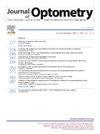Efficacy of a progressive multifocal soft contact lens in myopia management in Caucasian children: A two-year follow-up
IF 1.8
Q2 OPHTHALMOLOGY
引用次数: 0
Abstract
Purpose
To evaluate myopia progression as assessed by changes in axial length (AL) and spherical equivalent (SE) from baseline in Caucasian children wearing multifocal soft contact lenses (MCL) compared to single-vision distance spectacles. Methods: Forty progressing (at least -0.75D increase in previous 12 months) myopic children (7–12 years old) with SE ranging from -0.75 to -4.50 D were recruited in a longitudinal prospective non-randomized study. 20 were fitted with MCL (+2.50D add), whereas 20 wore single-vision distance spectacles. Cycloplegic refraction was measured with an auto-refractometer (Topcon TRK-2P, Japan) and AL with IOLMaster 700 (Carl Zeiss, Germany). Subjective responses related to vision and comfort of MCL wear were determined with a questionnaire scaled from 0 (very poor) to 10 (excellent). Results: After 2 years, mean change in SE/AL in the MCL group was - 0.82±0.25D/0.51±0.02 mm and -1.12±0.14D/0.66±0.03 mm in the spectacles group (all p < 0.001). Cumulative Absolute Reduction in Axial Elongation (CARE) was 0.15 mm. Difference in SE change was 0.30D. 97.5 % of children in the spectacles group showed an AL increase of between 0.61 and 0.70, and 70 % of eyes showed an SE increase of −1.00 D. In the MCL group, there was no case with an elongation >0.60 mm, with 67.5 % of eyes being between 0.51 and 0.60 mm. In contrast, over half of the MCL group exhibited lower SE progression, from 0.50 to 0.75 D. Conclusion: A slower myopia progression rate was achieved with a centre distance MCL with +2.50D addition after two years of wear compared with the spectacles group.
渐进式多焦点软性接触镜治疗高加索儿童近视的疗效:两年随访
目的评价高加索儿童配戴多焦软性隐形眼镜(MCL)与单视距眼镜的眼轴长度(AL)和球面等效(SE)的变化情况。方法:选取40例进展性(前12个月至少-0.75D增加)近视儿童(7-12岁),SE范围为-0.75至-4.50 D,进行纵向前瞻性非随机研究。20人戴MCL (+2.50D),而20人戴单视距眼镜。使用自动折射仪(Topcon TRK-2P,日本)和ai仪(IOLMaster 700,卡尔蔡司,德国)测量睫状体麻痹性屈光。对MCL佩戴的视觉和舒适度的主观反应进行问卷调查,评分范围从0(非常差)到10(优秀)。结果:2年后,MCL组SE/AL平均变化为- 0.82±0.25D/0.51±0.02 mm,眼镜组SE/AL平均变化为-1.12±0.14D/0.66±0.03 mm(均p <;0.001)。累积绝对轴向伸长率降低(CARE)为0.15 mm。SE变化差异为0.30D。眼镜组97.5%的儿童的AL增加在0.61 - 0.70之间,70%的眼睛的SE增加在- 1.00 d之间。MCL组没有出现0.60 mm的延长,67.5%的眼睛在0.51 - 0.60 mm之间。相比之下,超过一半的MCL组表现出较低的SE进展,从0.50到0.75 d。结论:与眼镜组相比,佩戴两年后,中心距MCL +2.50D的近视进展速度较慢。
本文章由计算机程序翻译,如有差异,请以英文原文为准。
求助全文
约1分钟内获得全文
求助全文

 求助内容:
求助内容: 应助结果提醒方式:
应助结果提醒方式:


